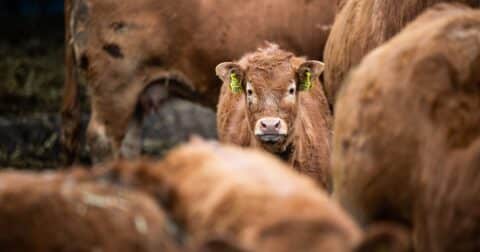Solutions
When Marine Parks Close, Whales and Dolphins Face Uncertain Future
Entertainment•7 min read
Reported
Millions in federal research dollars are going to ineffective solutions like regenerative agriculture.


Words by Julieta Cardenas
The food we eat is responsible for more than a quarter of all greenhouse gas emissions, yet government research studying how to curb emissions from food remains drastically underfunded. A new study from The Breakthrough Institute finds funding for clean energy research to be 22 times higher than the pot for agriculture, with a huge share going to a tactic with little evidence to back it up: carbon sequestration. The report estimates the government would need to spend an additional $1 billion to level the playing field.
Global greenhouse gas emissions come from a wide variety of sources but when it comes to the food sector, the largest driver of climate pollution is meat — primarily beef and dairy farms. That’s mainly because cattle, as ruminant animals, have four stomachs and a digestive system responsible for releasing a lot of methane through their burps, otherwise known as enteric fermentation.
Other major sources of climate pollution include land use, like clearing forest to let cows graze or to grow corn and soy for feed crops. Soils used to grow these crops can also release nitrogen emissions, thanks mostly to the way fertilizer is applied. And food waste — from crops leftover on the field to what’s tossed at restaurants and grocery stores — are also a big driver of emissions, accounting for 3.3 billion metric tons of carbon dioxide equivalent in 2010.
Climate models point to a number of strategies for reducing emissions from the food sector — some are low-tech, like shifting to more sustainable, plant-rich diets and others include technology, like feed additives or more efficient breeding. But just how much is the federal government investing in these strategies?
Dan Blaustein-Rejto, a researcher at The Breakthrough Institute and co-author of the report, analyzed where the federal government invested its climate research dollars for agriculture between 2017 and 2023, and found $92 million went to soil carbon sequestration projects out of $262 million in total, with very little scientific evidence of efficacy to show for it.
Over the past 12,000 years that humans have farmed, the planet has released 110 billion metric tons of carbon from the world’s top layer of soil. Carbon goes into soils when plants and other organic matter breaks down. Some of that carbon will stick around for a long time, often in wild landscapes like forests. Getting that carbon to stick around in agricultural soils, however, has proven far more tricky, and the federal government has spent millions trying to figure it out.
Researchers have spent years studying the capacity for regenerative practices like reduced-till farming, cover-crops and rotational grazing to sequester carbon in the soil. But despite all of the “hype” for regenerative farming as a climate solution, says Blaustein-Rejto, the science largely doesn’t back up these practices, at least as a climate solution. It mostly boils down to this: in agricultural soils, any carbon that goes into the soil tends to stay on the top layer and cycle right out into the atmosphere again.
Despite the dearth of evidence, the government is funding programs for farmers to plant cover crops such as clover, beans and peas, along with no-till farming. There is $132 million in federal spending going to the U.S. Department of Agriculture’s Agricultural Research Service programs, including initiatives that support regenerative practices.
Methane emissions from cattle burps, otherwise called enteric fermentation, are responsible for 32 percent of agricultural emissions, yet strategies to tackle this source of methane receive only eight percent of the funding, the report found. Blaustein-Rejto and The Breakthrough Institute favor solutions that aim to make the food system more productive, as opposed to more resource-heavy strategies like grass-fed beef or agroecology.
The authors argue that technologies to address enteric fermentation like feed additives need more funding and multi-year studies. In past research, some scientists have found seaweed additives to be only marginally effective and for beef, feed additives can only be fed to cows at the end of their life in feedlot, which leaves the methane pollution from their time on pasture untouched and unabated.
Crop breeding technologies could also be a promising area for further research and funding, argue Breakthrough’s researchers. One proposed avenue is to breed annual crops with perennial traits in order to prevent replanting every season, and crops with enhanced roots. For now, there is a massive gap between current funding and what researchers need to put these technologies into practice. For instance, National Academies of Sciences researchers estimated enhanced root research would need $40-50 million per year for two decades, which is “about 4 to 5-times more than recent federal funding levels.”
Microbial fertilizers, or fertilizers that rely on microorganisms to boost plant nutrition, could be another promising tool for climate action. These could reduce industrial agriculture’s reliance on synthetic fertilizers, as well as harmful water pollution from excess fertilizer.
Federal funding, much like the public’s attention (and climate news coverage), has largely been focused on efforts to decarbonize, or move away from our dependence on fossil fuels. “Many people have said that agriculture is maybe 20 years behind energy,” says Blaustein-Rejto. There could be many reasons for this lag, he says. People tend to feel more personally attached to food choices than energy sources, or it could be the uptick in clean energy solutions offered in recent years. The bottom line: we are only just beginning to see an increase in awareness for climate solutions for our food system, and we have a long way to go to get it right.